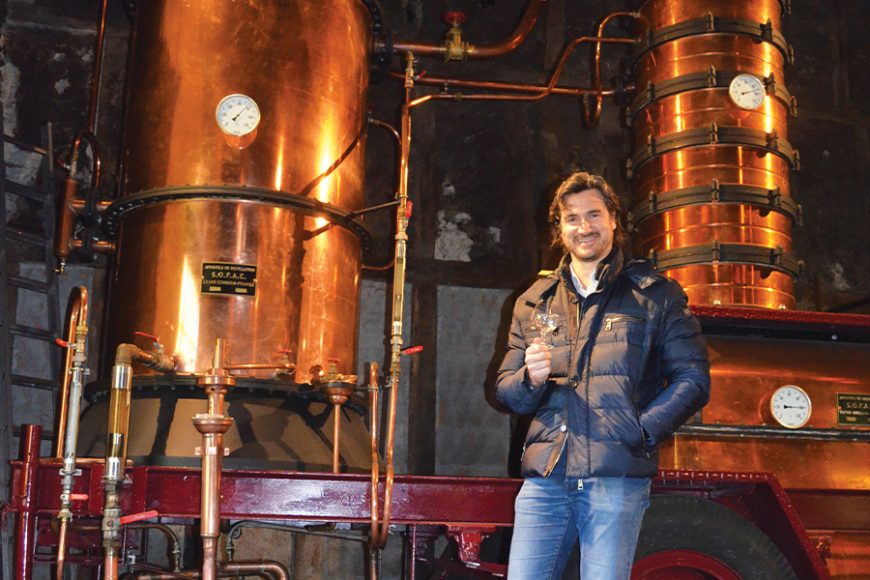I traveled to the Southwest of France about 12 years ago on a media trip to taste the wines of the region. There are many subregions of wine production spanning this massive, 300-mile-wide area, with geographical islands of wine production ranging from the Pyrenees on the Spanish border to the Languedoc-Roussillon wine region. During one dinner with several winemakers, one producer pulled out a bottle of Armagnac from his cellar and introduced it as a grape-based distilled spirit that he called “Cognac’s rustic cousin.” I just returned from a second trip to the region and tasted many Armagnacs from many decades, the oldest vintage being from 1893.
We visited one Armagnac production house, Domaine d’Espérance, owned by Jean-Louis and Claire de Montesquiou, who bought an estate and began Armagnac production in 1990. After a lovely tour and luncheon in their kitchen with many Armagnacs to taste, Claire said, “I don’t want to be the rustic cousin of Cognac.’ Our Armagnacs are very elegant, far from rustic.”
Well, the region is decidedly rustic, with narrow two-lane roads in quaint villages where you could open the car window and touch the homes on a pass-through. It’s common to see locals foraging for mushrooms, berries or dandelions right beside the road. The farms are comprised of charming, historic buildings with old trucks and tractors and a dearth of visible, modern commercial farming equipment. The restaurants we dined in were small mom-and-pop operations with a bucolic menu and service. But the Armagnacs we tasted throughout our visit were lovely, expressive of the region and its terroir and decidedly not rustic.
Armagnac production predates Cognac by a century and a half and, for many small producers then and now, it was made as an insurance policy, a hedge against a monetary slump, an asset in the cellar that could be monetized when necessary for a new car, tuition, a wedding or retirement. Indeed, many were taught to put away some barrels for the future and old barrels are still frequently found tucked away.
Cognac production is largely controlled by four houses — Rémy Martin, Courvoisier, Hennessey and Martel. Cognac grapes, almost all Ugni Blanc, are grown on 185,000 acres compared with a little more than 10,000 acres of planted grapes in Armagnac. In Armagnac, 10 grape varietals are allowed, with the most production being Ugni Blanc, Folle Blanche, Baco Blanc and Colombard. Both Cognac and Armagnac are grape-based brandies. The grapes are harvested, fermented into a low alcohol wine and then distilled into a clear eau-de-vie (“water of life”) spirit. This spirit is then oak-aged, blended and bottled for popular consumption. Most Armagnac is distilled once. Cognac is distilled twice. Each distillation removes congeners and flavor. I have heard wine producers say many times, “Good wine starts with the fruit.” Brandy producers historically used bad wines to make brandy. I heard several Armagnac producers say, “Better grape production makes better wine and better wine makes far better Armagnac.”
The Armagnac region is subdivided into three regions — Bas Armagnac to the west, Armagnac-Tenareze in the middle and Haut Armagnac to the east. Each subregion has different soils and micro climates and each imparts different flavors to its product. Each producer chooses barrel types and a degree of toast or char on the barrel, which has a profound effect on the taste. And some regions or producers create a fresher, more floral bouquet. Some exhibit a smooth spiciness, while some cradle the palate with savory oak flavors.
One Armagnac producer, Baron de Lustrac, owns no vineyards. It has no grape presses or fermentation tanks. It has no distillation machinery. It simply buys Armagnac barrels from 20 different producers that meet its criteria of flavor profile. It continues the aging process until just the optimal moment and then blends and bottles on request. Château de Tariquet, on the other hand, is a multigenerational operation with vast vineyards and every piece of modern fermentation and distillation equipment. It crafts its Armagnac from buds on the vine through to oak aging the distillate, which infuses the eau-de-vie with flavors of pepper, spice, orange peel, licorice, toffee, caramel and cinnamon.
Armagnac might not be readily available in small retail shops in the U.S., but larger outlets should have some respectable options and if not, could certainly order some. Look for Janneau, Delord, Château de Pellehaut, Darroze, Esperance, Castarede, Marquis de Montesquiou, Château de Laubade and Dartigalongue. All of these producers have a long and unique history of production and are crafting high-quality, ethereal and mesmerizing Armagnacs.
If you get a chance to visit the region, virtually all the production houses will gladly welcome visitors and offer extensive tastes and romantic stories. Show your appreciation with a purchase or two. And the best news for people wishing to discover Armagnac. High-quality bottles can be had for a small percentage of an aged Cognac. I bought a beautiful bottle of 1974 Janneau Grand Armagnac in a magnificent oak presentation box for about $110. I have fallen in love with all things Armagnac and brought home several bottles. The sips are heady and lovely, and its elegance belies the region. The Armagnac elixir shared with a friend or two will create memories of flavor and celestial conversation. Armagnac is so not rustic.
Write me at doug@dougpaulding.com.


